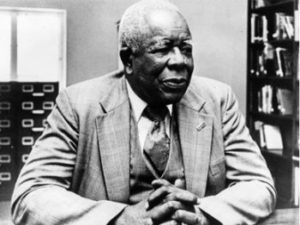
Edgar D. Nixon
*Edgar D. Nixon was born on this date in 1899. He was a Black civil rights leader and union organizer.
From Lowndes County, Alabama, Edgar Daniel Nixon was the son of Wesley M. Nixon and Sue Ann Chappell Nixon. His adolescent years were spent in Montgomery. Nixon's mother died when he was a boy, and he and his seven siblings lived with several family members as youths. He received little formal education, but at six feet, four inches tall and possessing a charismatic spirit and a deep baritone voice, he had a natural ability to organize and rally people around a cause.
In 1926, Nixon and his first wife, Alease (who died in 1934), had a son, E. D. Nixon Jr. (1928-2011), an actor who went by the stage name Nick La Tour. His second wife, Arlette Nixon, became a fixture at his side in the Montgomery civil rights movement. He was the head of the Pullman Porters Union's Montgomery branch and president of the local NAACP.
He was director of the Montgomery Welfare League and the Montgomery Voters League at various times. Nixon had campaigned for civil rights, particularly voting rights, for years before the bus boycott. He was an unelected advocate for Montgomery's Black community, interceding for those who asked for his help with white officeholders, police, and civil servants. He organized a group of 750 men who marched to the Montgomery County courthouse in 1940 to attempt to register to vote.
He ran for a seat on the county Democratic executive committee in 1954 and questioned candidates for the Montgomery City Commission on their position on civil rights issues the following year. At that same time, Nixon and members of the Women's Political Council began looking for a way to challenge the discriminatory seating practices on Montgomery's buses that a local ordinance required.
He rejected several potential plaintiffs–one because she appeared to lack the fortitude to see the case through, another because she was an unwed mother, and a third because her father had drinking problems before Rosa Parks, the elected secretary of the Montgomery NAACP, was arrested on December 1, 1955. Nixon went to bail her out after a family friend called to tell him she had been arrested. Based on his years of working with Parks, Nixon felt sure that she was the ideal candidate to challenge the discriminatory seating policy; even so, Nixon had to persuade Parks to lead the fight and only succeeded after she conferred with her mother and husband. Nixon arranged for Clifford Durr, a local white lawyer, to represent her. Nixon then called several local ministers to organize support for the boycott; the third one he called was a relatively young and newly arrived minister, Martin Luther King Jr., who asked for time to think about it.
By the time King called back, Nixon informed him that the meeting had already been arranged to take place at his church. Nixon, who could not attend because work took him out of town, took precautions to see that no one was elected to lead the campaign until he returned. On his return, he met with Rev. Ralph David Abernathy and Rev. E.N. French to plan the program for the next meeting. Between them, they came up with a list of demands, a name for the organization, the Montgomery Improvement Association (MIA), and a President, Dr. King.
Nixon recommended King to Abernathy and French because dealing with the local white power structure had not, in his view, compromised King. Things did not go as Nixon envisioned when he met with a larger group of ministers to prepare for that next meeting; however, the ministers were timid, trying to organize a boycott so discreetly that white Montgomery would not notice. Nixon threatened to denounce them all as cowards, which spurred King to respond that he was no coward. King accepted the presidency of the MIA and delivered the keynote address that evening. Nixon became the treasurer of the MIA.
A bomb was set off in front of his home on February 1, 1956. The boycott ended successfully, lasting for 381 days, following the United States Supreme Court's decision that Montgomery's segregation policy was unlawful. Nixon later described the Montgomery Bus Boycott to an audience of supporters in New York City's Madison Square Garden: I'm from Montgomery, Alabama, a city that's known as the Cradle of the Confederacy, that had stood still for more than ninety-three years until Rosa L. Parks was arrested and thrown in jail like a common criminal. Fifty thousand people rose and caught hold of the Cradle of the Confederacy and began to rock it till the Jim Crow rockers began to reel and the segregated slats began to fall out.
Nixon continued to have sharp disagreements with others in the MIA during those years, expressing resentment at those, including King and Abernathy, who received more credit than those local activists who had put in years struggling against racism; he ultimately resigned as treasurer of the MIA with a bitter letter to King complaining that he had been treated as a child. He continued to feud with Montgomery's Black middle-class community for the next decade, losing his leadership status in the wake of political defeats in the late 1960s. After retiring from the railroad, he worked as the recreation director of a public housing project. Daniel Nixon, a vital administrator who organized the Montgomery Bus Boycott, died on February 25, 1987.